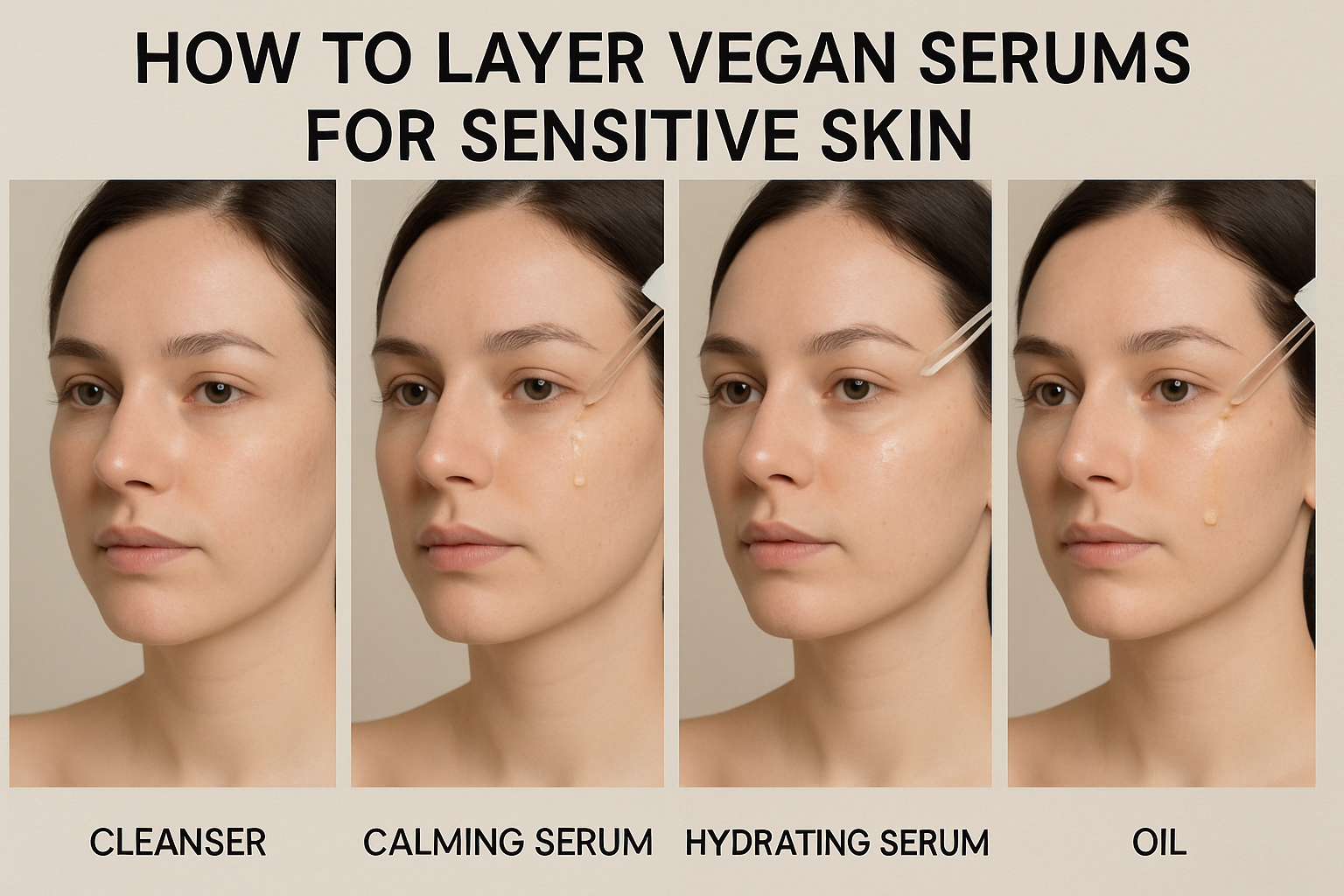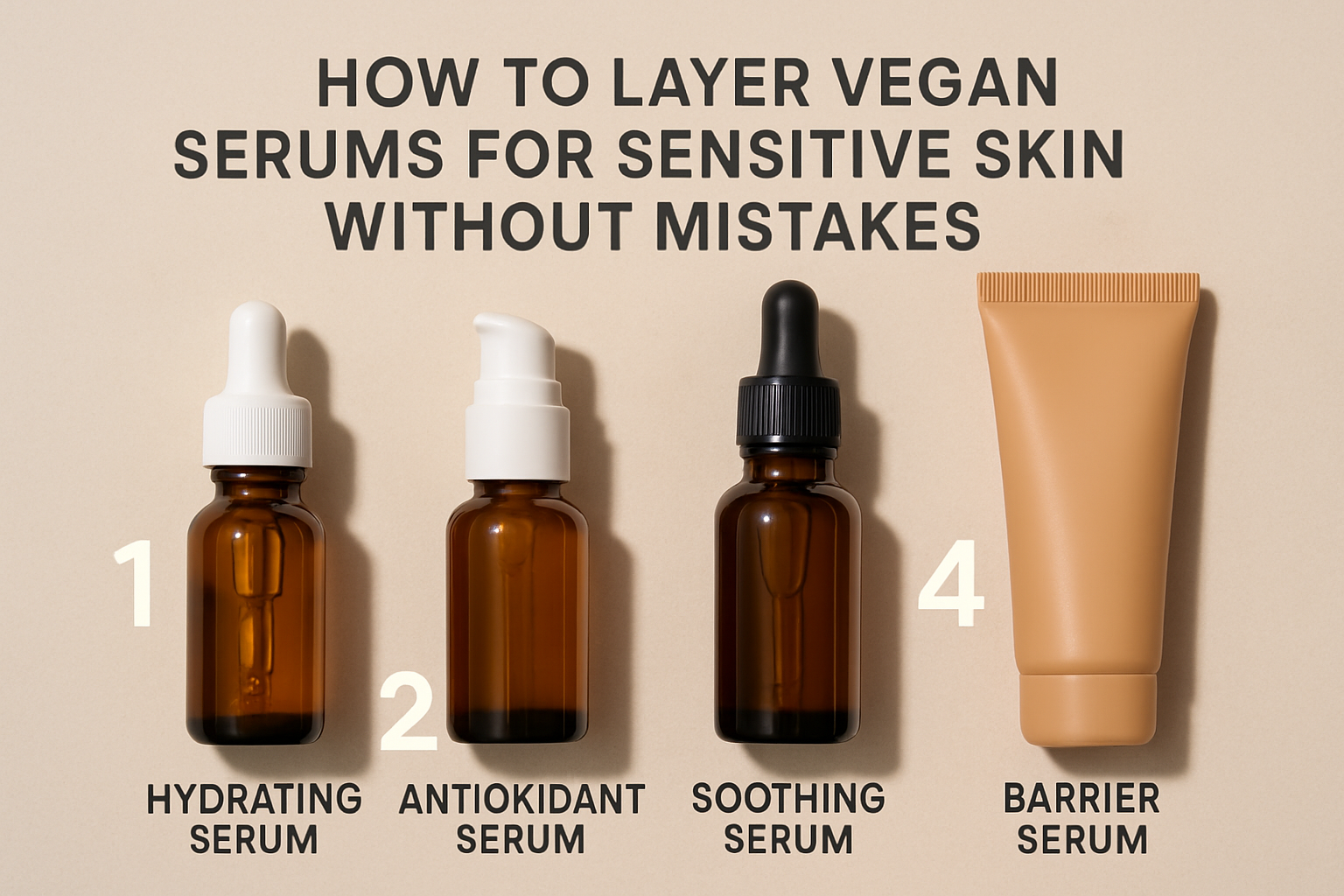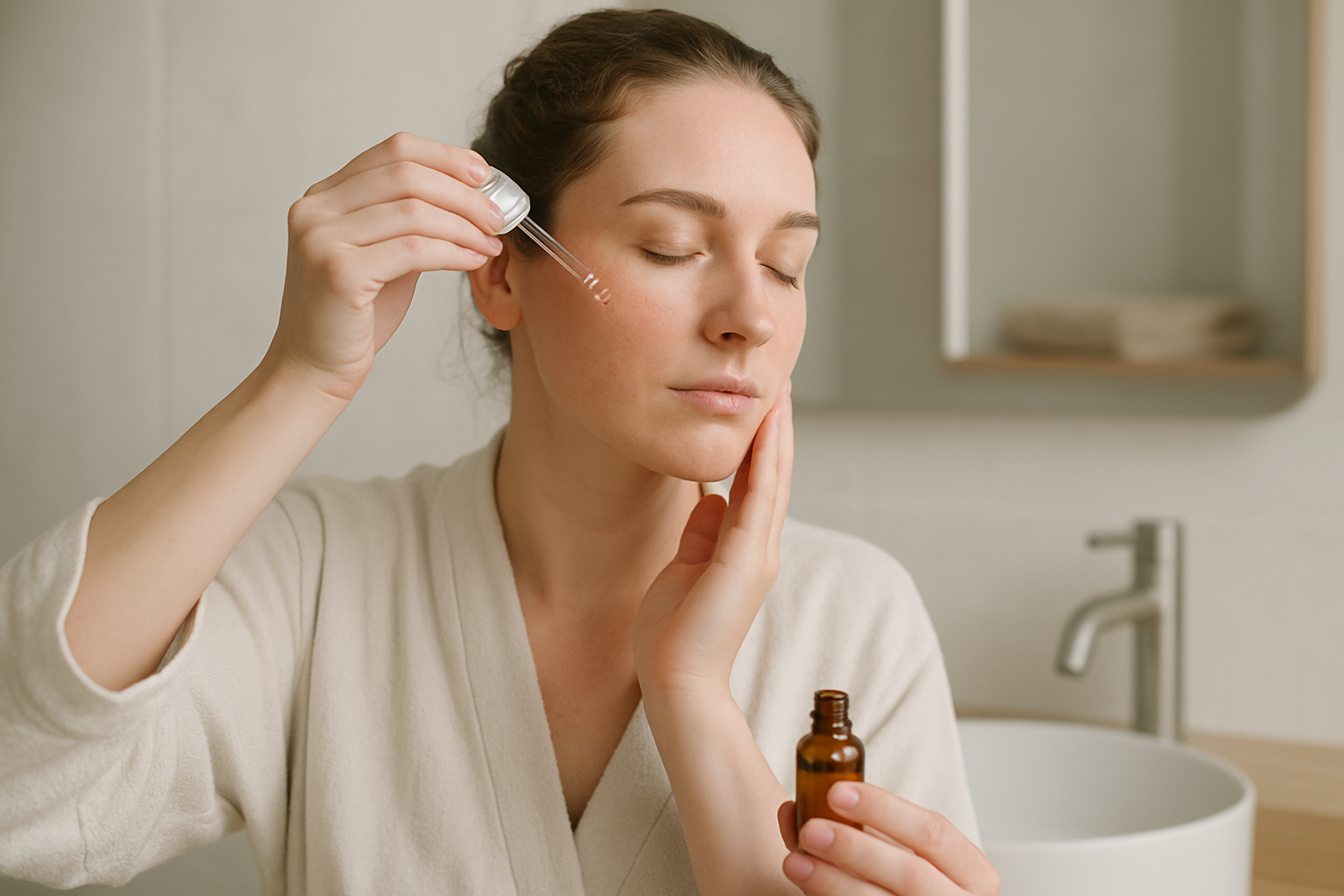
How to Layer Vegan Serums for Sensitive Skin: A Gentle, Effective Approach
Share
Layering vegan serums is a celebrated step in modern skincare.
But what are they, exactly?
This guide offers a complete cheatsheet on how to layer vegan serums for sensitive skin.
Some are formulated for hydration without irritation.
Some blend organic actives that soothe while brightening.
Some boast cruelty-free certifications that ensure ethical joy in self-care.
Some gently support your skin barrier with natural, fragrance-free ingredients.
Some carry the COSMOS certification for trust and transparency.
Let's dive right in.
Why Is Layering Serums Important for Sensitive Skin?
Layering serums correctly is like composing a symphony for your skin. Sensitive skin especially benefits from a careful sequence because it needs gentle, targeted nourishment without triggering irritation.
Each serum delivers specific benefits — hydration, calming, brightening, or barrier strengthening — and layering optimizes how these benefits interact and absorb. For sensitive skin, this approach allows you to manage concerns such as redness, dryness, and sensitivity with precision.
At its best, layering is a mindful ritual of self-care that honours skin's delicate nature while offering visible results.
For example, a hydrating serum with high molecular weight hyaluronic acid creates a moisture barrier, essential for sensitive skin prone to dryness and irritation. Adding a calming serum rich in ceramides next supports the skin barrier, reducing redness and strengthening resilience.
Without layering thoughtfully, active ingredients could clash or overwhelm sensitive skin, leading to discomfort or flare-ups. Therefore, knowing how to layer vegan serums correctly brings both efficacy and gentleness — essential for sensitive skin lovers who seek clean, conscious beauty routines.
Tip: Always patch test serums before full application, especially for sensitive skin.
What Are Vegan Serums and Why Choose Them for Sensitive Skin?
Vegan serums are skincare formulations made without animal-derived ingredients or by-products. Beyond ethical beauty, they often emphasise plant-based, organic actives that truly soothe sensitive skin.
Many vegan serums align with certifications like COSMOS, ensuring more than 90% organic content, no synthetic nasties, and cruelty-free manufacturing. This transparency is vital for sensitive skin, which reacts poorly to harsh chemicals and artificial fragrances.
For instance, serums like the Love + Rose Hydrating Serum show how organic ingredients combined with clean formulations hydrate and calm without irritation. Its 79% organic content and absence of silicones or mineral oils make it a gentle choice for sensitive skin.
Choosing vegan serums also supports sustainability – a commitment to the planet that resonates deeply with users embracing mindful self-care.

Step-by-Step: How to Layer Vegan Serums for Sensitive Skin
Ready for the how-to? Here is a trusted sequence designed especially for sensitive skin using vegan serums.
1. Start with a Clean and Toned Canvas
Begin with a gentle, fragrance-free cleanser tailored for sensitive skin to remove impurities without stripping natural oils.
Apply a hydrating toner or essence next to prep your skin—something soothing and alcohol-free.
This initial step readies your skin to absorb serums more effectively.
2. Apply the Lightest Textured Serum First
The rule of thumb is to layer in order of consistency—from the thinnest to the thickest.
Usually, water-based serums with humectants like hyaluronic acid come first to draw moisture into your skin gently.
The Love + Rose Hydrating Serum is an exemplary light serum for sensitive skin, using high molecular weight hyaluronic acid that forms a breathable moisture barrier without heaviness.
Gently pat this serum onto slightly damp skin to lock in hydration effectively.
3. Follow with Targeted Treatment Serums
Next, apply serums designed for specific concerns such as redness, pigmentation, or texture.
If you struggle with redness or a compromised skin barrier, a ceramide-rich serum like the Avocado Ceramide Recovery Serum is ideal. It features plant-based ceramides identical to those in your skin, helping reduce visible redness and strengthen barrier health.
For dark spots or uneven tone, serums with niacinamide and tranexamic acid — ingredients clinically proven to fade discoloration — can be layered next. Check out serums similar to the Faded Brightening Clearing Serum, known for reducing dark spots and protecting the moisture barrier.
Important: Avoid layering these brightening or acid-containing serums directly with AHAs, BHAs, or retinoids to minimise irritation.
4. Seal in with a Plant-Based Moisturizer
After serums, apply a gentle, vegan moisturizer to lock in hydration and protect.
Opt for fragrance-free formulas designed for sensitive skin.
Learn more about choosing the perfect moisturiser in our guide on organic moisturizer for sensitive skin.
5. Don’t Forget Sunscreen in Your Daytime Routine
Always finish with a broad-spectrum SPF to protect sensitive skin from UV damage, which can worsen redness and pigmentation.
Select vegan, cruelty-free sunscreens free from potential irritants.
Did you know? Layering serums enhances each product’s absorption and effectiveness, but applying too many at once can stress sensitive skin. Prioritise your routine to what your skin truly needs.

How Often Should You Layer Serums for Sensitive Skin?
Consistency is key, but so is balance.
For sensitive skin, layering serums once or twice daily is typically sufficient—morning and night routines each tailored accordingly.
In the morning, stick to hydrating and calming serums followed by SPF.
At night, you may add gentle brightening or restorative serums if your skin tolerates it well.
Always listen to your skin. Signs of redness, itching, or dryness indicate you might need to cut back or simplify your layering.
Which Ingredients Are Best in Vegan Serums for Sensitive Skin?
Choosing serums with the right ingredients transforms your routine from guesswork to nourishing science.
- Hyaluronic Acid: Powerful hydrator that retains moisture and plumps skin without heaviness.
- Ceramides: Lipid molecules that restore and strengthen the skin barrier, reducing redness and sensitivity.
- Niacinamide: Vitamin B3 derivative that brightens, calms inflammation, and improves texture.
- Tranexamic Acid: Effective at fading stubborn discoloration and hyperpigmentation safely.
- Shea Butter & Glycerin: Provide gentle moisturization while protecting the moisture barrier.
- Plant Extracts (e.g. Centella Asiatica, Licorice Root): Soothing botanicals that calm irritation and promote healing.
These ingredients are often found in top vegan serums like Faded Brightening Clearing Serum and Glow Recipe’s Avocado Ceramide Recovery Serum.
Quick tip: Look for serums that are fragrance-free or have natural scents only, as fragrances often trigger sensitivity.
How to Avoid Common Mistakes When Layering Vegan Serums
Even gentle serums can cause issues if they’re not layered thoughtfully. Here’s what to watch out for:
- Mixing incompatible actives: Avoid combining AHAs, BHAs, retinoids, and brightening acids directly at the same time. They may irritate sensitive skin.
- Applying too many products: Overloading your skin can lead to congestion or reactive flare-ups.
- Skipping patch tests: Always test new serums on a small skin area first to check tolerance.
- Ignoring product textures: Start layering thinnest to thickest for better absorption.
- Neglecting moisturiser and SPF: Serums alone aren’t enough; sealing and protecting your skin is essential.
Mastering these tips helps your sensitive skin thrive while benefiting fully from your vegan serum routine.

Can I Layer Vegan Serums with Other Skincare Products?
Absolutely. Serums are designed to be part of a harmonious skincare ritual.
Layer serums under lightweight moisturisers, oils, or balms specially formulated for sensitive skin.
Choose fragrance-free, gentle formulas to avoid overwhelming your skin.
For example, a calming ceramide serum paired with a vegan, organic moisturiser and followed by sunscreen completes a balanced, protective routine.
Curious how moisturisers fit into your routine? Discover expert advice in The Ultimate Guide to Organic Moisturizer for Sensitive Skin.
What Do Other Users Say About Layering Vegan Serums for Sensitive Skin?
Customer experiences highlight that choosing the right vegan serums transforms sensitive skin care from trial to cherished ritual.
Users of the Love + Rose Hydrating Serum praise its non-sticky, instantly absorbing texture and calming power that leaves red, dry skin soothed and visibly plumper.
Many attest to feeling more confident with reduced redness after incorporating ceramide serums like Glow Recipe’s Avocado Ceramide Recovery Serum.
Others appreciate that serums bred for sensitive skin provide gentle yet noticeable brightening, fading dark spots without irritation, as seen with products like Faded Brightening Clearing Serum.
These testimonials echo a broader community desire for vegan, cruelty-free options that not only perform but nurture self-love and environmental responsibility.
Frequently Asked Questions About Layering Vegan Serums for Sensitive Skin
How soon will I see results from layering vegan serums?
Visible improvements vary depending on your skin’s sensitivity and concerns. Many users notice hydration and plumping effects within days, while brightening and barrier repair benefits typically emerge after 4-6 weeks of consistent use. (Verified with sources as of 2025-08-30)
Can I layer more than two serums at once?
It’s best to limit serums to two or three per routine for sensitive skin to avoid overstimulation. Prioritize serums addressing your primary concerns and always patch test when introducing new products.
Are vegan serums safe for eczema-prone sensitive skin?
Many vegan serums formulated with calming ceramides and botanical extracts are suitable for eczema-prone skin, though individual reactions vary. Consult a dermatologist and start with patch tests.
Can I layer vitamin C serums with other treatments safely?
Yes, but choose vitamin C formulations designed for sensitive skin and avoid combining with strong exfoliants or retinoids in the same routine to reduce potential irritation.
What's Your Next Step?
Tell us in the comments: How will you apply this to your sensitive skincare routine? For personalised advice, contact us!

Related Reading
Explore more about cruelty-free skincare with Lulumine’s exclusive insights on Navigating Vegan Cruelty Free Skincare in the UK.
Expand your knowledge about brightening ingredients and dark spot solutions in Discover the Best Dark Spot Serum: Science-Backed Solutions for Radiant Skin.
This comprehensive guide embodies the transparent, science-backed, and caring ethos that Lulumine stands for — a ritual that’s as much about self-love as it is about skincare results.
For those seeking tailored men’s skincare advice, check out this expert guide on face serums for men, offering insights complementary to this vegan, sensitive skin-focused approach.
Data and product insights referenced from trusted sources including Topicals, One Love Organics, and Glow Recipe.
